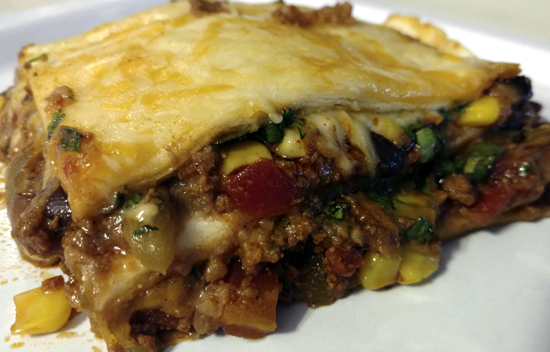
A completed serving of Taco Casserole, without any of the optional toppings.
Two summers ago when I was Kitchen Manager at the Skyroom at Indiana Beach I had the pleasure of spending a lot of time with a man we called Chuey. Jesus Valdes Dominguez lived outside Mexico City, but during that summer and the twenty preceding summers he traveled to the Skyroom to work in the kitchen for the entire season.
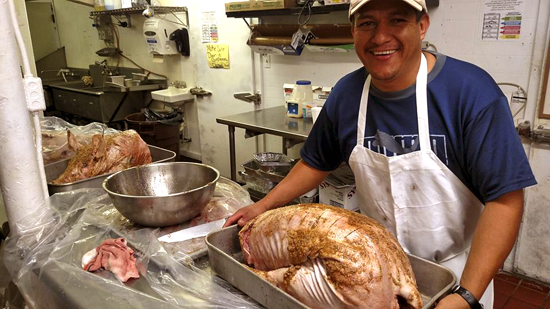
Chuey doing the prep to roast a couple 50 lb hogs in July of 2015. He cut them into halves so they’d fit into the tall but narrow roasting ovens.
I was hired on that summer solely as Kitchen Manager. I’ve become quite good at organizing professional kitchens, getting the ordering systems right, building spreadsheets for monthly inventories, making sure things at least make a little bit of sense. … All the technical reasons I was called out-of-the-blue by a former supervisor and brought on-board in the spring of 2015. But there were longtime cooks there who always called me “Chef”, and Chuey was one of those cooks. Of course, he’s one of the many excellent cooks I’ve known throught my life whom I’ve learned a lot from. But in his case, it’s his sense of humor that stands out as one of his best traits.
July 25, 2015, 4:00 a.m.: More than 2,000 to cater for today. Dragged my ass out of bed an hour ago, tried to focus my eyeballs to continue an online discussion on coneys, downed two cups of coffee before slowly lumbering to the restaurant 200 feet from my cottage … The sound of rapidly running feet behind me, I glanced back to see a figure flying toward me, I’m scared witless … 43-year-old Chuey goes flying by and races up the eighteen steps to the door … before he’s had his first cup of strong Mexican coffee. Laughing maniacally at the door he bellows “Chef, Chuey mucho loco!!!” Yup, he done be cray-cray …
Later in the summer, as my health started to take another tumble (I finally received a much-needed pacemaker on November 15, 2016) Chuey took it upon himself to make sure I was taken care of in regards to meals. Regardless of how busy he was, regardless of what I had going on, he would throw another serving of his own meals of authentic Mexican cuisine together, wrap the second serving in film, place it on my desk, and demand I take the time to eat.
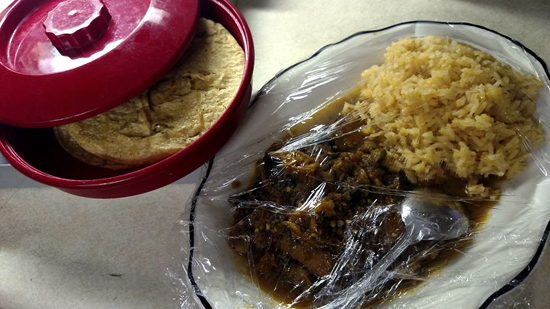
Chuey: “Chef, you go eat!”
Me: “We’re behind, I gotta get this done!”
Chuey: “No Chef, you get sick later …” [points at me] “I tell your wife!!!”
Dammit …
I’m experienced enough in running professional kitchens to know when to let cooks thrive. If they’re under my supervision, and they want to do something unique, and it’s possible to let them go off-menu, I’m more than happy to let them go. Our first experiment with pork belly was to rub it with a mix of brown sugar, salt, pepper, garlic, and a lot of herbs, let it sit for 24 hours, sear it on the flattop, then cook it for 3-1/2 hours in a 50/50 brine of chicken stock and Budweiser at 225F. It was like butter when it was done and had amazing flavor. That we cut it up for a high-end Pork & Beans for the Father’s Day buffet just made it more fun. Jenelle Solomon from Jamaica, a Chef in her own right without accepting the title, later took more of the pork belly, mixed together her own jerk seasoning rub for it, let it sit overnight again, then cut and grilled individual slabs for sandwiches for another buffet. Letting excellent cooks be creative helps everyone learn, and as none of us had attempted pork belly prior to this and that we all felt good about the results is what counts in recipe and menu item development.
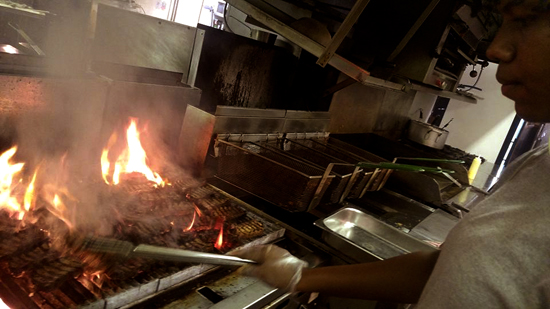
Jenelle Solomon, grilling off slabs of Jamaican Jerk Pork Belly, July 5, 2015.
I learned more about what real Mexican food is about from Chuey than he probably realizes. There are specific packaged ingredients available here in the U.S. that Mexican families use on a regular basis. You just have to find them. Believe me, that’s not difficult to do. Many larger grocery stores carry the right products in a special “ethnic” section, but there are enough real Mexican groceries around that it’s even simpler to go to one and find what Mexican families are using in their own kitchens. You’ll likely pay less there for the same items, too. In Monticello, Indiana, that Mexican grocery is actually inside Esmeralda’s, an authentic Mexican restaurant Chuey himself ate at. That’s where he would pick up the ingredients for his own meals in the Skyroom, and would later share with me. (In nearby Monon, Indiana, the grocery was also attached to a Mexican restaurant next door, and had its own butcher shop and fishmonger as well.) So I learned rapidly what worked for him, and what he would turn his nose up at.
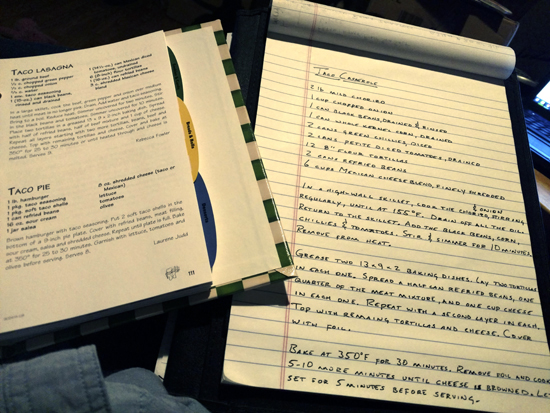
The Bronner’s staff cookbook and its Taco Lasagna, along with the write-up for the resulting Taco Casserole.
I’ve been an avid collector of cookbooks for quite some time now, and have more than 400. The past few years I’ve gotten rather picky about which cookbooks I’ll add to the collection. One category of cookbooks to be particularly picky about is that of the “fundraiser” cookbooks, generally published by local organizations by the ubiquitous Morris Press Cookbooks for the past umpteen yea … er, since 1933. The majority of these cookbooks have, unfortunately, become rehashes of one another. But at the same time, businesses use Morris Press to publish their own “staff” cookbooks. These collections are rather well curated, especially when the business wants to stay within a target audience or occasion. The two staff cookbooks from Bronner’s CHRISTmas Wonderland in Frankenmuth, Michigan, “Bronner’s Flavorful Favorites“, one from 2005 and the other from 2008, are excellent examples of this. I added these two cookbooks to my collection about a month ago, and have really enjoyed browsing the holiday-specific recipes.
Quite a few of the recipes in the Bronner’s cookbooks are intended for family gatherings through the holidays. One in particular caught my eye, the Taco Lasagna in Book 2 as submitted by Bronner’s staffer Rebecca Fowler. Our family as a whole loves Mexican food, to the point where I keep the large foodservice container of taco seasoning in the pantry. The kids and grandkids come to visit us almost every weekend, and large recipes are necessary on a regular basis anymore. So the Taco Lasagna became something to seriously consider.
But as I looked at Ms. Fowler’s recipe my mind took the leap: How would my good man Chuey make this? What changes would I need to make to make it palatable for him if he were here? To raise the level of authenticity?
Hoping not to offend Ms. Fowler in what I’m certain is a seriously nice dish, I immediately knew calling it a “lasagna” wasn’t something Chuey would have agreed with. He made his own lasagna for the restaurant in a very specific manner, and had for years. He begged me to get him the right lasagna, an uncooked pasta sheet that had never been dried, which took me a good month to find. He then proceeded to make his own sauce and meat mixture from scratch, used all the right Italian cheeses, and par-baked the batches while finishing servings individually. His lasagna would put most others to shame. Pasta-maker Barilla, founded in 1877, agrees with him. In their now-out-of-print book “I Love Pasta: An Itallian Love Story in 100 Recipes” from their Academia Barilla, the Barilla family members wrote about how the pasta was mentioned in ancient Greek and Roman descriptions of cooking. The end the paragraph with “There is also an industrial version with curled edges”, referring specifically to what most westerners are used to seeing and cooking.
Chuey would have made this baked dish for a buffet, meaning we would call it a “casserole” on the menu.
Chuey never used ground beef spiced with taco seasoning in the dishes he made for him and I. He always used pork chorizo, generally the mild variety. The real thing is made with salivary glands, lymph nodes and cheek fat, and other cuts of pork. This follows the centuries-old Central American cultures always being nose-to-tail, and is authentic, whether or not squeamish Americans want to admit it. The seasoning is correct for what Americans call “taco seasoning”, so no additional spices are necessary.
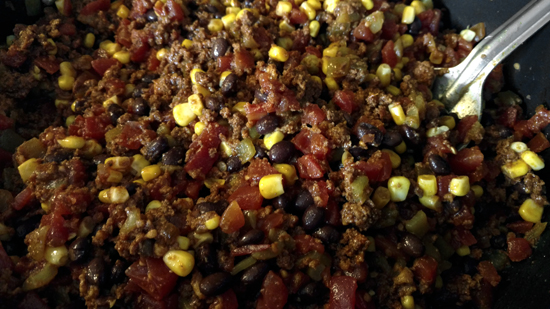
The meat mixture after simmering.
The basics of Ms. Fowler’s recipe are good, but I think Chuey would have made at least a few changes. Knowing I’m making a double batch means I can replace one of the cans of black beans with a can of Chuey’s beloved whole kernel corn. “Mexican” tomatoes are merely tomatoes with green chillies added. By splitting out the chillies I can adjust the amount of heat, the hotter the better. And no Mexican dish is right without a good bunch of chopped fresh cilantro.
About those canned vegetables: The Mexican versions of these canned goods are indeed authentic. They’re less processed than their American counterparts, have considerably fewer ingredient, and in many instances are imported from Mexico or other regions of Central America. They also taste better than what’s made in the U.S. and are used in Mexican family kitchens every day.
Finally, we’ll tweak out the process just a bit, heating the refried beans until they’re smooth so they’re easier to spread, draining the tomatoes and chillies so the resulting casserole holds together and the tortillas don’t get soggy, adding the possibility of greasing the casserole dishes with lard, and adding optional toppings.
The end result had people going back for seconds and thirds. Really, it’s that good. And all kinds of variations are possible. Give this a shot. Your family will be glad you did.
Taco Casserole
Ingredients
- 2 lbs pork chorizo, raw El Mexicano brand
- 1 cup onion, chopped
- 1 can black beans, drained and rinsed Herdez or La Preferida brand
- 1 can corn, whole kernel, drained
- 2 cans green chillies, diced, drained La Victoria brand
- 2 cans tomatoes, petite diced, drained
- 2 cans refried beans Herdez or La Preferida brand
- 2 cups cilantro, fresh, chopped
- 6 cups Mexican cheese blend, finely shredded
- 12 8" flour tortillas La Banderita or Mission brand
- sour cream for topping (optional)
- 2 cups Mexican cheese blend, finely shredded for topping (optional)
- salsa Herdez or La Preferida brand, for topping (optional)
Instructions
- In a high-wall skillet over medium heat, cook the chorizo and onion for about 15 minutes, until the meat has crumbled completely. (With good chorizo, it will not change color.)
- Place a stack of paper towel or a lint-free cloth on a plate. Transfer the cooked meat to the plate and allow the oil to drain.
- Using a slotted spoon, gently transfer the meat back to the skillet. Add the black beans, corn, shillies and tomatoes.
- Simmer, stirring occasionally, for 10 minutes. (The corn should still have a nice crunch.) Remove from the heat.
- Dump the two cans of refried beans into a sauce pan, stirring occasionally, and heat just until smooth. Remove from the heat. (This allows for the refried beans to be used more easily in the next step.)
- Use lard or vegetable shortening (lard is preferable) to grease two 13″ x 9″ x 2″ glass casserole dishes. Lay two tortillas in each one. On the tortillas in each dish, spread one-quarter of the refried beans, followed by one-quarter of the meat mixture, one-quarter of the cilantro, and one cup of the shredded cheese. Top each with two more tortillas, and then build a second layer identical to the first. Top with the remaining tortillas and one more cup of cheese each. Cover each dish with aluminum foil, being sure to “tent” the foil upward in the middle so it isn’t contacting the top layer of cheese.
- Bake at 350F for 30 minutes. Let set for 5 minutes before serving. Top each serving with sour cream, more shredded cheese, salsa, or other optional toppings.
Notes
- Play around with the ingredients. Increase or decrease the seasonings to taste, use hot chorizo if you'd like, or even top each serving with a fried egg. The possibilities are endless.
- Replacing the chorizo with cubes of slow-cooked beef tongue seasoned with taco seasoning would make for another authentic version, as would using pulled pork or chunks of slow-cooked pork belly seasoned in the same manner.
- This makes a lot of Taco Casserole. You can also do the assembly in the same size foil casserole pans, cover with foil, then freeze immediately to cook at a later date.

Sometimes I think you should be a writer!! I’ve never tasted your cooking, but your writing is “right up there” !